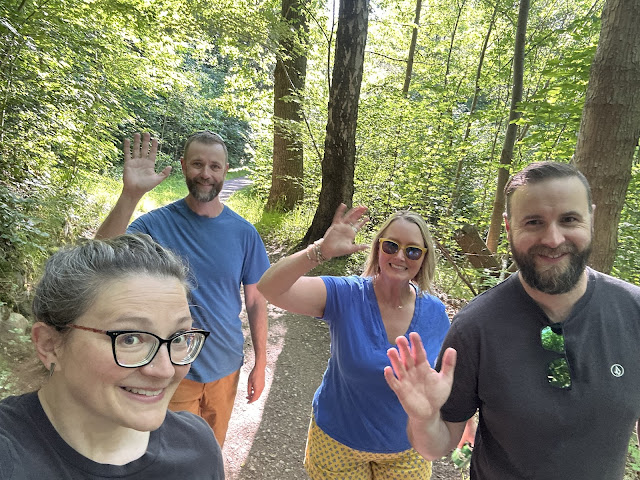The Danish Language
As I mentioned in my "Catching up" post, Zac and I have started Danish lessons! Since I've been around Danes off and on for more than a decade, I do understand that the Danish language contains sounds that the English language just doesn't have (some weird guttural "r"), and I also am aware of their extra vowels.
Æ Å Ø
That doesn't mean I know anything about actually using those vowels or making those sounds. Although, Zac's colleagues showed him a satire video that suggests Danes don't actually know how to speak their language, either. It's very funny.
https://youtu.be/vvtDGSIrsk8?si=vhATSh_xc4tJFqqv
Figuring out the sounds is the first struggle. On past work trips, I've tried to give the address of the ALK headquarters to my taxi driver. Here's how it goes EVERY TIME:
Me: I need to go to BOE-gay al-LAY one in HER-sholm.
Taxi driver: Where?
Me: BOO-gay ALLEE one? In HUR-sholm?
Taxi driver: ...
Me: BUH-GHEE all-AY? One? HER-shulm?
Taxi driver: Can I see?
[I show him the address on the phone: Bøge Alle 1, Hørsholm]
Taxi driver: Ah! Bhoo-yeah Al-leh. Yeah.
Me (thinking): I swear that's what I said...
Anyway, that's pretty much our lives now.
People we meet ask where we live. We say, "Birkerød."
They cock their heads to the side and furrow their brows and ask us to repeat it. We say it again, trying desperately to tweak our vowels so that the noises coming from our mouths might make sense.
"Bir-ke-rød," we say, enunciating carefully.
They correct us. "Birkerød?"
Yes. That's what I said! I thought, anyway. It sounds the same to me!!
The second struggle is that there are two "genders" for words, and the "gender" indicates whether you use "en" or "et" to say "a [noun]." So to say "a banana," you must know that "banana" is "common gender," and thus you would say, "en banan." An apple, on the other hand, is the "neuter gender," so you would say "et æble" instead of "en æble."
In languages like Spanish that also have two genders, the genders are male and female, so in general, it's easier to figure out if you should use "el" or "la." (As a rule of thumb, Spanish words that end in -o are masculine and use el, and words that end in -a are feminine and use la). Since Danish has "common" and "neuter" genders rather than "male" and "female," it's impossible to even guess what a given noun might be, and there are no rules. You just have to know.
This also impacts how you modify the adjective to describe the noun. You can have a big dog (en stor hund) or a big tree (et stort træ), and the word for "big" will have a "t" at the end of it if it's a neuter gender word. It's hard.
The third struggle is that the way a word is written, even if you know how to say all the letters, is not always the way it's pronounced, and often, the ends of words are just dropped altogether. "Det er..." is just pronounced "Dee..." The word to negate something, ikke, is technically kind of like EEK-eh, but most people just say it like EEK. These, again, are just things you have to learn and for which there are no rules.
* * *
We learned numbers the other day. I talked about it with a colleague at work after that, and he gave a brief history about why the words for the numbers are so weird. The next week, kind of coincidentally, I got a message from Katie and Jack about an image they saw online showing how to say "92" around the world. Take note of the weirdness happening next to the Danish flag.
 |
| how-to-say-number-92-in-european-countries-v0-d9acdi1kxa4a1.png |
To say 92 in Danish, the word is "tooghalfems."
Breaking it down, that's saying 2 (to) and (og) 90 (halvfems). The word for 90, halvfems, is derived from when the Danes used to count by 20s many years ago. If you were counting by 20s, 90 would have been four whole 20s and one half-20 (halv-fem-sinds-tyve). So technically, the Danish word for 92 is exactly as the graphic shows:
2+(5-0.5)x20
* * *
So learning Danish is kind of a struggle. All the vowels seem to say "oo." There are no rules to explain why things are the way they are. We're just trying our best and hoping that someday, someone will understand us.
We are expanding our vocabularies though, and that helps when we're trying to decipher ads or read headlines. Sometimes, we can even read the entire thing! It will take a lot of practice though.
Zac got to practice numbers at work recently when his Danish colleague was reading values off the data recording system (in Danish) for Zac to write down. I got to practice numbers as I did my Christmas shopping because in many places, I had to take a number ticket and wait for my number to be called before they would ring up my purchases.
We're at a very awkward time in our language journey because we can understand it better than we can speak it. An example:
A store clerk and I greeted each other, but our greetings sound the same in Danish and English. "Hi!" is "Hej!" in Danish, and they both sound like the English word. So at that point, she doesn't know that I speak English.
Next, she asks me, in Danish, if my purchase is a gift. I understand and say, "Yeah," while nodding. Again, my response sounds pretty much the same in Danish and English. "Yeah" and "Ja" are pronounced very similarly.
She tells me how much my total is, and since I know some numbers, I know what she's saying, and the amount appears on the card reader. I scan my phone to pay for the purchase. She asks if I want my receipt, and I say, "Ja, tak." (Yes, thank you.)
She then asks me something in Danish that I don't understand at all, so I say, "I'm sorry, I don't speak Danish."
Now she's confused because as far as she can tell, we've been conversing only in Danish the entire time, and now she feels bad that she didn't speak English to me before this moment and apologizes. She asks me, in English, if I need to buy a bag and I say no, pulling out my shopping bag and putting my items into it. She hands me a receipt and I thank her in Danish.
This kind of interaction makes me feel anxious, because I say I don't speak Danish, but then I clearly do a little bit. I guess I just need to practice saying, "I'm sorry, I'm still learning Danish." I think that will alleviate my anxiety.
* * *
Ways that we practice our Danish in everyday life:
- Simple verbal responses to colleagues at work
- Listening to Danish songs once in a while (and reading along with the lyrics)
- Reading Danish subtitles on English movies
- Sending each other text messages in Danish
- Reading the local headlines when the paper comes, looking up the words we don't know if we are only missing one or two of them
- Deciphering signs in stores
- Watching Danish ads on the internet
- Reading the Danish emails and trying to figure out what they say before we click "Translate to English"
* * *
We'll pick our classes up again after the new year, and of course, continue all that stuff above. It all builds confidence and I love that we have friends, colleagues, and neighbors that are willing to answer our questions about why things are the way they are, correct our pronunciation, and teach us new words. Danish is hard, and most people say we won't be comfortable speaking it, even badly, for about two years, but hey, we're on our way!



Comments
Post a Comment